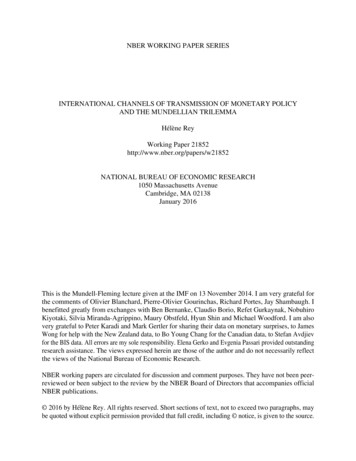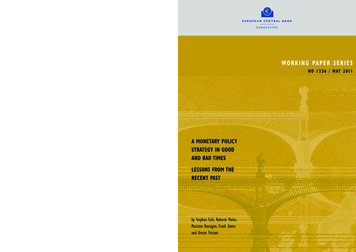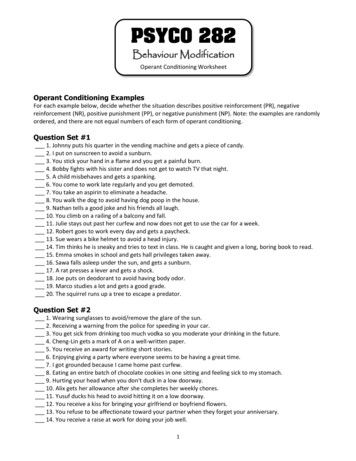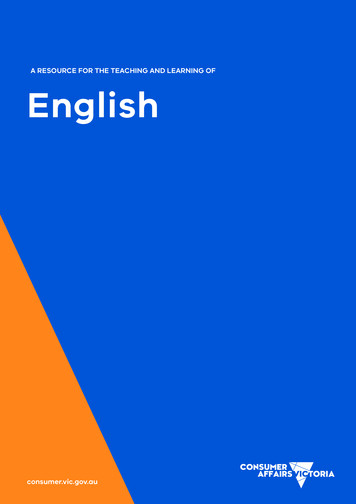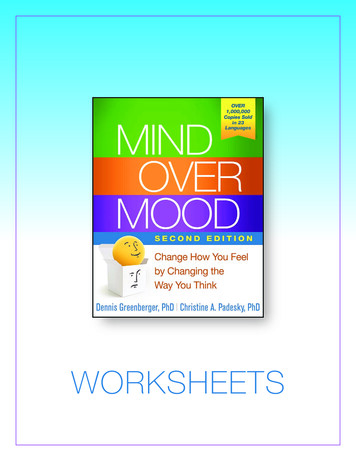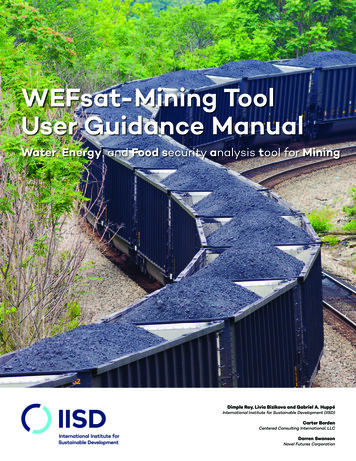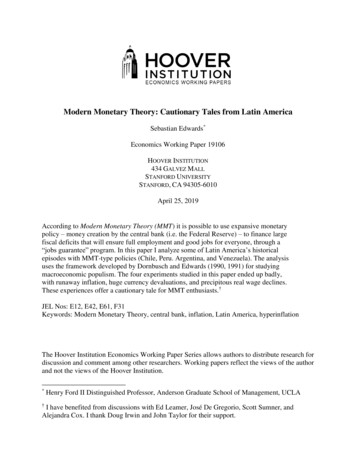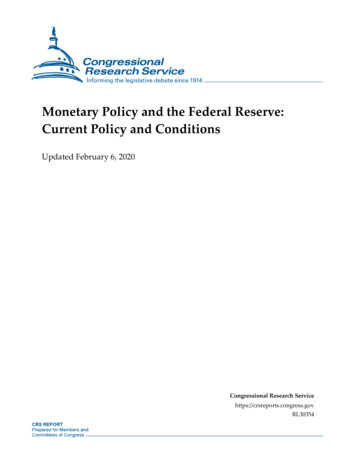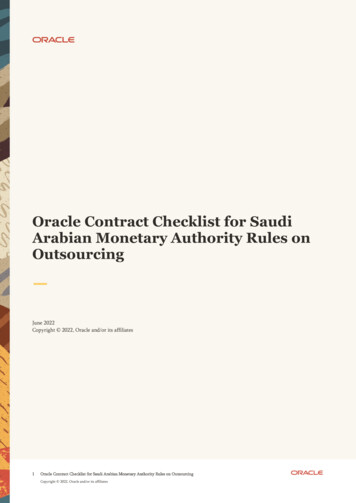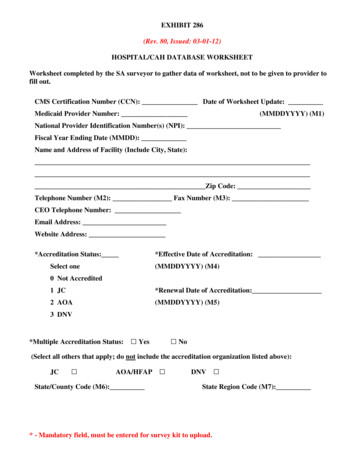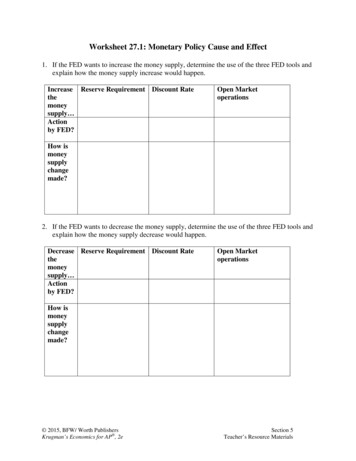
Transcription
Worksheet 27.1: Monetary Policy Cause and Effect1. If the FED wants to increase the money supply, determine the use of the three FED tools andexplain how the money supply increase would happen.Increase Reserve Requirement Discount Ratethemoneysupply Actionby FED?Open MarketoperationsHow ismoneysupplychangemade?2. If the FED wants to decrease the money supply, determine the use of the three FED tools andexplain how the money supply decrease would happen.Decrease Reserve Requirement Discount Ratethemoneysupply Actionby FED?Open MarketoperationsHow ismoneysupplychangemade? 2015, BFW/ Worth PublishersKrugman’s Economics for AP , 2eSection 5Teacher’s Resource Materials
Copyrighted Material - Do Not Post Answers OnlineWorksheet 27.1: Monetary Policy Cause and EffectAnswer Key1. If the FED wants to increase the money supply, determine the use of the three FED tools andexplain how the money supply increase would happen.Increase Reserve Requirement Discount Ratethemoneysupply Lower the requirement Lower the discountActionrateby FED? percentageHow ismoneysupplychangemade?When the requirementpercentage is lower,banks have moreexcess reserves tomake loans and moneysupply is increased.When the discountrate is lower, bankscan borrow fundsat lower cost. Theycan make moreloans and moneysupply is increased.Open MarketoperationsBuy governmentsecuritiesWhen the FED buysbonds, a deposit demandis created. Banks canmake more loans afterthey set aside therequired reserves and themoney supply isincreased.2. If the FED wants to decrease the money supply, determine the use of the three FED tools andexplain how the money supply decrease would happen.Decreasethemoneysupply Actionby FED?How ismoneysupplychangemade?Reserve Requirement Discount RateOpen MarketoperationsRaise the requirementpercentageWhen the requirementpercentage is higher,banks have fewerexcess reserves tomake loans and moneysupply is decreased.Sell governmentsecuritiesWhen the FED sellsbonds, buyers use theirfunds from a depositdemand. Banks havefewer excess reservesand the money supply isdecreased. 2015, BFW/ Worth PublishersKrugman’s Economics for AP , 2eRaise the discountrateWhen the discountrate is higher, bankscan borrow less atthe higher cost.They make fewerloans and moneysupply is decreased.Section 5Teacher’s Resource Materials
Worksheet 27.2: Bank RequirementsAfter reading the October 2013 Huffington Post article “Federal Reserve ToughensRequirements For Biggest Banks,” on liquidity coverage ratios found e-liquidity n 4158388.html, answer thefollowing questions.1. What is the liquidity coverage ratio?2. Why is the Fed proposing this new policy?3. Why might financial institutions oppose the new policy?4. Do you think the new policy will replace the required reserve ratio? Explain. 2015, BFW/ Worth PublishersKrugman’s Economics for AP , 2eSection 5Teacher’s Resource Materials
Copyrighted Material - Do Not Post Answers OnlineWorksheet 27.2: Bank RequirementsAnswer KeyAfter reading the October 2013 Huffington Post article “Federal Reserve ToughensRequirements For Biggest Banks,” on liquidity coverage ratios found e-liquidity n 4158388.html, answer thefollowing questions.1. What is the liquidity coverage ratio?The liquidity coverage ratio is a policy that requires banks to have a specific amount ofliquid assets in order to withstand a run on the bank or a credit crunch.2. Why is the Fed proposing this new policy?The Fed is proposing this new policy to prevent another situation like the one from 20062007, when reduced lending and a system-wide move to hoard cash and safe securities suchas U.S. government debt led the Fed to pump trillions of dollars directly into financialcompanies to ensure markets didn’t collapse.3. Why might financial institutions oppose the new policy?Banks won’t be able to count some assets as cash, decreasing the amount of money they canloan out.4. Do you think the new policy will replace the required reserve ratio? Explain.Answers will vary. 2015, BFW/ Worth PublishersKrugman’s Economics for AP , 2eSection 5Teacher’s Resource Materials
Worksheet 27.3: Tools of Monetary PolicyUse the tools of monetary policy and what you learned in previous lessons to answer each of thefollowing questions.1. The central bank would like to decrease unemployment in the economy. What open marketoperation would be appropriate?2. Name two ways a central bank could decrease inflation in an economy.3. Suppose that the reserve ratio is 10% when the Fed buys 150,000 of U.S. Treasury billsfrom the banking system. If the banking system does NOT want to hold any excess reserves,calculate the change in the money supply.4. Suppose that the reserve ratio is 10% when the Fed buys 100,000 of U.S. Treasury billsfrom the banking system. If the banking system holds an additional 10% in excess reserves,calculate the change in the money supply.5. Suppose the reserve requirement is 20% when the Fed sells 20,000 of U.S. Treasury bills tothe banking system. If the banking system does NOT want to hold any excess reserves,calculate the change in the money supply.6. Suppose real GDP is 750 trillion while potential GDP is 1,000 trillion. What open marketoperation could the central bank use to close the gap? How much would open marketoperation need to be if the reserve requirement was 10%?7. Suppose real GDP is 2,500 trillion while potential GDP is 1,000 trillion. What openmarket operation could the central bank use to close the gap? How much would open marketoperation need to be if the reserve requirement was 20%? 2015, BFW/ Worth PublishersKrugman’s Economics for AP , 2eSection 5Teacher’s Resource Materials
Copyrighted Material - Do Not Post Answers OnlineWorksheet 27.3: Tools of Monetary PolicyAnswer KeyUse the tools of monetary policy and what you learned in previous lessons to answer each of thefollowing questions.1. The central bank would like to decrease unemployment in the economy. What open-marketoperation would be appropriate?Buy treasury bills2. Name 2 ways a central bank could decrease inflation in an economy.Any 2: Sell treasury bills, increase the reserve requirement, or increase the discount rate3. Suppose that the reserve ratio is 10% when the Fed buys 150,000 of U.S. Treasury billsfrom the banking system. If the banking system does NOT want to hold any excess reserves,calculate the change in the money supply.MM 1/.10 10; 10 x 150,000 1,500,000 increase in the money supply4. Suppose that the reserve ratio is 10% when the Fed buys 100,000 of U.S. Treasury billsfrom the banking system. If the banking system holds an additional 10% in excess reserves,calculate the change in the money supply.MM 1/.2 5; 5 x 100,000 500,000 increase in the money supply5. Suppose the reserve requirement is 20% when the Fed sells 20,000 of U.S. Treasury bills tothe banking system. If the banking system does NOT want to hold any excess reserves,calculate the change in the money supply.MM 1/.2 5; 5 x 20,000 200,000 decrease in the money supply6. Suppose real GDP is 750 trillion while potential GDP is 1,000 trillion. What open marketoperation could the central bank use to close the gap? How much would open marketoperation need to be if the reserve requirement was 10%?To fix the recessionary gap of 250 trillion, the central bank should buy T-bills. MM 1/.1 10. 250/10 25 trillion purchase of T-bills.7. Suppose real GDP is 2,500 trillion while potential GDP is 1,000 trillion. What openmarket operation could the central bank use to close the gap? How much would open marketoperation need to be if the reserve requirement was 20%?To fix an inflationary gap of 1,500 trillion, the central bank should sell T-bills. MM 1/.2 5. 1,500/5 300 trillion sale of T-bills. 2015, BFW/ Worth PublishersKrugman’s Economics for AP , 2eSection 5Teacher’s Resource Materials
Exit Slip: Module 271. Suppose the Federal Reserve were to engage in open-market operations by buying 100million of U.S. Treasury bills. Which of the following would be the end result of such anaction?A. The money supply would stay the same.B. The money supply would decrease by 100 million.C. The money supply would increase by 100 million.D. The money supply would increase by more than 100 million.E. The money supply would increase, but by less than 100 million.2. When the Fed decreases bank's reserves through an open-market operation:A. deposits increase, currency in circulation increases, and the monetary base remainsthe same.B. the monetary base decreases, the money multiplier decreases, and the money supplyincreases.C. loans increase, the federal funds rate rises, and the discount rate rises.D. the monetary base decreases, loans decrease, and the money supply decreases.E. the monetary base decreases, loans decrease, and the money multiplier decreases.3. When a bank borrows from the Federal Reserve, it pays theA. required reserve ratio.B. discount rate.C. federal funds rate.D. prime rate.E. mortgage rate. 2015, BFW/ Worth PublishersKrugman’s Economics for AP , 2eSection 5Teacher’s Resource Materials
Copyrighted Material - Do Not Post Answers OnlineExit Slip: Module 27Answer Key1. Suppose the Federal Reserve were to engage in open-market operations by buying 100million of U.S. Treasury bills. Which of the following would be the end result of such anaction?A. The money supply would stay the same.B. The money supply would decrease by 100 million.C. The money supply would increase by 100 million.D. The money supply would increase by more than 100 million.E. The money supply would increase, but by less than 100 million.(D)2. When the Fed decreases bank's reserves through an open-market operation:A. deposits increase, currency in circulation increases, and the monetary base remainsthe same.B. the monetary base decreases, the money multiplier decreases, and the money supplyincreases.C. loans increase, the federal funds rate rises, and the discount rate rises.D. the monetary base decreases, loans decrease, and the money supply decreases.E. the monetary base decreases, loans decrease, and the money multiplier decreases.(D)3. When a bank borrows from the Federal Reserve, it pays theF. required reserve ratio.G. discount rate.H. federal funds rate.I. prime rate.J. mortgage rate.(B) 2015, BFW/ Worth PublishersKrugman’s Economics for AP , 2eSection 5Teacher’s Resource Materials
MODULE 27: THE FEDERAL RESERVE SYSTEM: MONETARYPOLICYIn-Class Presentation of Module and Sample LectureSuggested time: This module can be covered in two hour-long class sessions, with additional time spenton more examples or possibly a video.One possibility for a video is titled “Inside the World’s Mightiest Bank”:https://www.youtube.com/watch?v 4rus-GP-74gI.II.The Federal Reserve SystemA.The Functions of the Federal Reserve System1.Financial Services2.Supervise and Regulate Banking Institutions3.Maintain Stability of the Financial System4.Conduct Monetary PolicyWhat the Fed DoesA.The Reserve RequirementB.The Discount RateC.Open-Market OperationsI.The Federal Reserve SystemThe Fed has two parts: the Board of Governors, which is part of the U.S. government, and the 12 regionalFederal Reserve Banks, which are privately owned.But what is it that the Fed actually does?A.The Functions of the Federal Reserve SystemThere are four basic categories: providing financial services to depository institutions, supervising andregulating banks and other financial institutions, maintaining the stability of the financial system, andconducting monetary policy.Note: The AP Macro exam will stress monetary policy over all other functions of the Fed.1. Financial ServicesThe Federal Reserve is sometimes referred to as the “banker’s bank” because it holds reserves, clearschecks, provides cash, and transfers funds for commercial banks—all services that banks provide for theircustomers.The Federal Reserve also acts as the banker and fiscal agent for the federal government.The U.S. Treasury has its checking account with the Federal Reserve, so when the federal governmentwrites a check, it is written on an account at the Fed.2. Supervise and Regulate Banking InstitutionsThe Federal Reserve System is charged with ensuring the safety and soundness of the nation’s bankingand financial system. The regional Federal Reserve banks examine and regulate commercial banks intheir district. The Board of Governors also engages in regulation and supervision of financial institutions. 2015, BFW/Worth PublishersKrugman’s Economics for AP , 2eSection 5, Module 27 Page 1Teacher’s Resource Materials
3. Maintain Stability of the Financial SystemThe Fed is charged with maintaining the integrity of the financial system. As part of this function,Federal Reserve banks provide liquidity to financial institutions to ensure their safety and soundness.4. Conducting Monetary PolicyOne of the Federal Reserve’s most important functions is the conduct of monetary policy.As we will see, the Federal Reserve uses the tools of monetary policy to prevent or address extrememacroeconomic fluctuations in the U.S. economy.II.What the Fed DoesThe Federal Reserve has three main policy tools at its disposal: reserve requirements, the discount rate,and, perhaps most importantly, open - market operations. These tools play a part in how the Fed performseach of its functions as outlined below.A.The Reserve RequirementBanks that fail to maintain at least the 10% required reserve ratio on average over a two-week period, facepenalties.Suppose a bank looks as if it has insufficient reserves to meet the Fed’s reserve requirement. The bankcan borrow additional reserves from other banks via the federal funds market, a financial market thatallows banks that fall short of the reserve requirement to borrow reserves (usually just overnight) frombanks that are holding excess reserves.The federal funds rate, the interest rate at which funds are borrowed and lent in the federal funds market,plays a key role in modern monetary policy.To alter the money supply, the Fed can change reserve requirements. How? If the Fed reduces the required reserve ratio, banks will lend a larger percentage of their deposits,leading to more loans and an increase in the money supply via the money multiplier. If the Fed increases the required reserve ratio, banks are forced to reduce their lending, leading toa fall in the money supply via the money multiplier. Under current practice, however, the Fed doesn’t use changes in reserve requirements to activelymanage the money supply. The last significant change in reserve requirements was in 1992.B.The Discount RateAlternatively, banks in need of reserves can borrow from the Fed itself via the discount window. Thediscount rate is the rate of interest the Fed charges on those loans. Normally, the discount rate is set 1percentage point above the federal funds rate in order to discourage banks from turning to the Fed whenthey are in need of reserves. This is called the “spread”.To alter the money supply, the Fed can change the spread between the discount rate and the federal fundsrate. How? If the Fed reduces the spread between the discount rate and the federal funds rate, the cost tobanks of being short of reserves falls; banks respond by increasing their lending, and the moneysupply increases via the money multiplier. 2015, BFW/Worth PublishersKrugman’s Economics for AP , 2eSection 5, Module 27 Page 2Teacher’s Resource Materials
If the Fed increases the spread between the discount rate and the federal funds rate, bank lendingfalls—and so will the money supply via the money multiplier.The Fed normally doesn’t use the discount rate to actively manage the money supply. The Fedtypically sets the discount rate at a certain gap above the federal funds rate. As the federal fundsrate moves, the discount rate is adjusted to maintain the gap.C.Open-Market OperationsIn an open-market operation the Federal Reserve buys or sells U.S. Treasury bills, normally through atransaction with commercial banks—banks that mainly make business loans, as opposed to home loans.To alter the money supply, the Fed can buy or sell U.S. Treasury bills. How? When the Fed buys U.S. Treasury bills from a commercial bank, it pays by crediting the bank’sreserve account by an amount equal to the value of the Treasury bills.For example, if the Fed buys 100 million of U.S. Treasury bills from commercial banks, thisincreases the monetary base by 100 million because it increases bank reserves by 100 million.When the Fed sells U.S. Treasury bills to commercial banks, it debits the banks’ accounts,reducing their reserves.For example, when the Fed sells 100 million of U.S. Treasury bills, bank reserves and themonetary base decrease.Note: Remind the students that the change in bank reserves caused by an open-market operation doesn’tdirectly affect the money supply. Instead, it starts the money multiplier in motion.If the Fed buys 100 million in T-bills from the commercial banks, the banks would lend out theiradditional reserves, immediately increasing the money supply by 100 million. Some of those loanswould be deposited back into the banking system, increasing reserves again and permitting a furtherround of loans, and so on, leading to a rise in the money supply.An open-market sale has the reverse effect: bank reserves fall, requiring banks to reduce their loans,leading to a fall in the money supply.Note: It should be noted that when the Fed directly injects money into a bank after buying Treasuries, thatthe bank is not required to hold a fraction of those dollars as required reserves. The money multipliertakes over on the entire amount. 2015, BFW/Worth PublishersKrugman’s Economics for AP , 2eSection 5, Module 27 Page 3Teacher’s Resource Materials
E. The money supply would increase, but by less than 100 million. (D) 2. When the Fed decreases bank's reserves through an open-market operation: A. deposits increase, currency in circulation increases, and the monetary base remains the same. B. the monetary base decreases, the money multiplier decreases, and the money supply increases.

